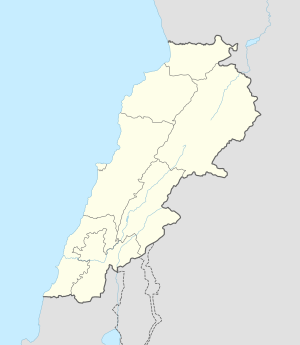Baalbek
|
Baalbek بعلبك |
|
|---|---|

|
|
| Location in Lebanon | |
| Coordinates: 34°0′22.81″N 36°12′26.36″E / 34.0063361°N 36.2073222°E | |
| Governorate | Beqaa Governorate |
| District | Baalbek District |
| Area | |
| • City | 7 km2 (3 sq mi) |
| • Metro | 16 km2 (6 sq mi) |
| Elevation | 1,170 m (3,840 ft) |
| Population | |
| • City | 82,608 |
| • Metro | 105,000 |
| Time zone | EET (UTC+2) |
| • Summer (DST) | +3 (UTC) |
| Type | Cultural |
| Criteria | i, iv |
| Designated | 1984 (8th session) |
| Reference no. | 294 |
| State Party |
|
| Region | Arab States |
Baalbek (/ˈbɑːlbɛk/), properly Baʿalbek (Arabic: ) and also known as Balbec,Baalbec or Baalbeck, is a town in the Anti-Lebanon foothills east of the Litani River in Lebanon's Beqaa Valley, about 85 km (53 mi) northeast of Beirut and about 75 km (47 mi) north of Damascus. It has a population of approximately 82,608, mostly Shia Muslims, followed by Sunni Muslims and a minority of Christians. It is reckoned a stronghold of the Hezbollah movement. It is home to the annual Baalbeck International Festival.
A few miles from the swamp from which the Litani (the classical Leontes) and the Asi (the upper Orontes) flow, Baalbek may be the same as the MBK NHRM ("Source of the Two Rivers"), the abode of El in the Ugaritic Baal Cycle discovered in the 1920s and a separate serpent incantation.
Heliopolis is the latinisation of the Greek Hēlioúpolis (Ἡλιούπολις), meaning "Sun City" in reference to the solar cult there. It is the earlier attested of the two names, appearing under the Seleucids and Ptolemies.Ammianus Marcellinus, however, does note that earlier "Assyrian" names of Levantine towns continued to be used alongside the official Greek ones imposed by the successors of Alexander. In Greek religion, Helios was both the sun in the sky and its personification as a god. The local Semitic god Baʿal Haddu was more often equated with Zeus or Jupiter or simply called the "Great God of Heliopolis", but the name may refer to the Egyptians' association of Baʿal with their great god Ra. It was sometimes described as Heliopolis in Syria or Coelesyria (Latin: Heliopolis Syriaca or Syriae) to distinguish it from its namesake in Egypt. In Catholicism, its titular see is distinguished as Heliopolis in Phoenicia, from its former Roman province Phoenice. The importance of the solar cult is also attested in the name Biḳāʿ al-ʿAzīz borne by the plateau surrounding Baalbek, as it references an earlier solar deity and not later men, named . In Greek and Roman antiquity, it was known as Heliopolis. It still possesses some of the best-preserved Roman ruins in Lebanon, including one of the largest temples of the empire. The gods that were worshipped there (Jupiter, Venus, and Bacchus) were equivalents of the Canaanite deities Hadad, Atargatis. Local influences are seen in the planning and layout of the temples, as they vary from the classic Roman design.
...
Wikipedia

